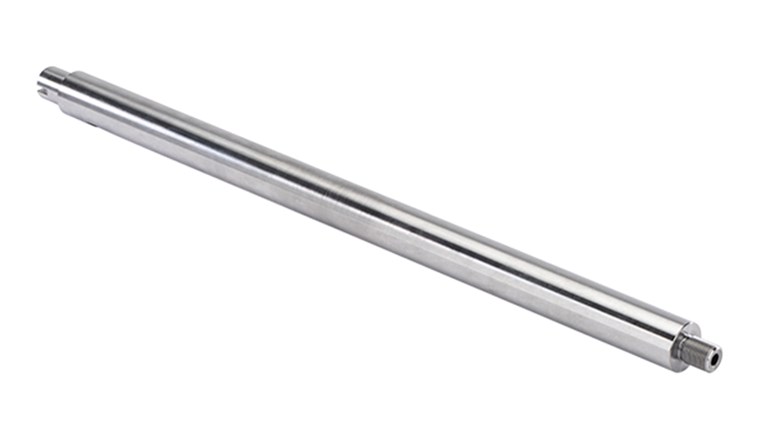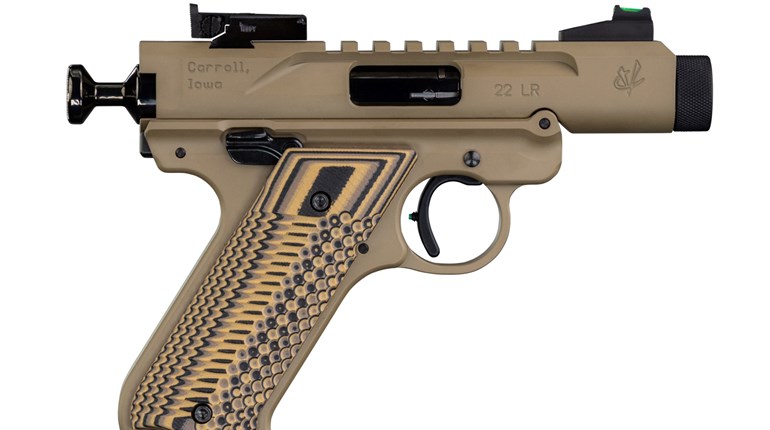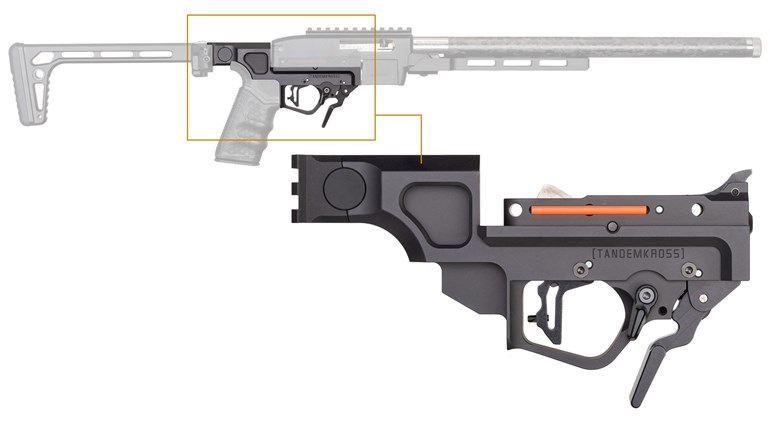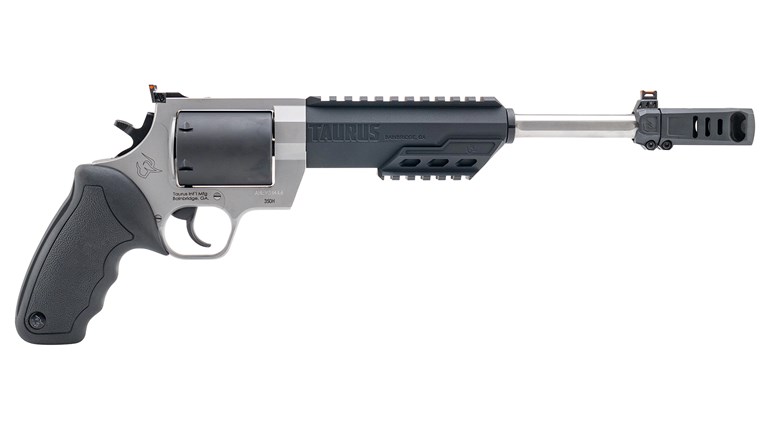
One could make a strong case for Steel Challenge being the most family-friendly action shooting sport. The courses of fire, range procedures and close supervision all make it easy for shooters of any age to participate. It’s also loads of fun, especially with .22 rimfire rifles being allowed in both iron sight (Rimfire Rifle Iron Sight) and optical sight (Rimfire Rifle Open Sight) divisions. Shouldering one of those and banging away at five steel plates isn’t much different than an old-time carnival shooting gallery.

This experience can be fun for the whole family, but acquiring multiple .22 LR rifles that properly fit the smallest and largest family members can get expensive. One model in Ruger’s 10/22 semi-automatic rimfire rifle line can reduce that bite on the wallet.
10/22 COMPACT
Ruger’s 10/22 Compact (Model No. 31114, $379, ruger.com) is the most affordable version of the proven 10/22 semi-automatic rimfire platform. With a lightweight synthetic stock, it weighs in at 4.4 pounds. The .22 Long Rifle barrel is 16.12-inches long, but not threaded to accept compensators or muzzle brakes. As for the iron sights, they consist of an adjustable rear with two red fiber-optic inserts and a fixed front ramp with green fiber-optic insert. The receiver is drilled and tapped for optics mounting plates and a combination Weaver tip-off plate is included.
Sporting Ruger’s Modular Stock system, the 10/22 Compact comes with a low comb for iron sight use with a 12½-inch length of pull. Overall length is 34 inches, a good fit for smaller-statured shooters. Additionally, it accepts all Ruger 10/22 accessories and magazines and ships with one 10-round magazine.

At first glance it’s a compact .22 LR rifle that will fit kids and smaller women with iron sights. But a few accessories greatly expand the 10/22 Compact’s potential.
The low comb works well for iron sights but is too low for a proper cheek weld with optical sights. The Modular Stock system (High Compact No. 90434, $21.95) that provides a high comb 12½-inch length of pull corrects this issue. If a Weaver base sight is chosen, the shooter is all set. But most competition-oriented reflex sights use a Picatinny mount, which won’t fit a Weaver base because the Picatinny cross piece is too wide. The solution: Ruger’s 10/22 Charger Picatinny Rail Scope Base Mount (No. 90465, $21.95), which fits the same mounting holes as the Weaver and accepts Picatinny reflex sights.

That 12½-inch length of pull is too short for most adults. But the Modular Stock Bundle Standard Pull (No. 26055, $36.95) provides a low and high comb with 13¾-inch length of pull. It takes just 30 seconds to change the buttstocks and the gun can now be properly fit—with iron or optical sights—to any member of the family, from a four-foot tall pre-teen to a large adult. And even with the accessories, the cost still comes out to less that than that of many similar rifles.
ON THE RANGE
First, I measured the trigger pull, which was the usual 5.4-pounds for a 10/22 factory trigger. I had requested a Ruger BX Trigger (No. 90462, $96.95) be included, since that 2¾-pound trigger is what I use in my Steel Challenge Rimfire Rifle Open Sight gun.
After a quick barrel swab and applying some light lubricant, I shouldered the gun to try the 12½-inch stock. As I suspected, it was too short for my five-foot, eight-inch frame. I hadn’t asked for the 13¾-inch stocks because the Ruger Takedown Lite that I shoot in Rimfire Rifle Open A Class has the Modular Stock system with both high and low standard combs. I installed the low comb and headed to my range to zero the iron sights. From a 25-yard bench rest the windage was dead on, but the elevation was five inches high. Turning down the rear sight zeroed the gun before the 10-round magazine was empty.

I then set up some white cut-out targets to simulate Steel Challenge stages and ran some transition drills. My first impression of the fiber-optic sights was that they were a bit skimpy, but after running them through the targets my opinion changed.
Next, I installed the Weaver scope base, using the high comb buttstock from my Takedown Lite, also mounting a 6-24x scope for accuracy tests at 50 yards. I used Lapua Center X, SK Rifle Match and CCI Green Tag for standard velocity loads, along with Remington Thunderbolt and CCI Segmented HP for high-speed loads. The included accuracy table shows the 10/22 Compact has more than enough accuracy. (The Ruger 10/22 Compact accuracy table is at the bottom of this article.)
Backyard shooting and benchrest tests will tell you something about the gun, but the real test is a match. I had wanted to get classified in Rimfire Rifle Iron Sights, but my one and only foray into that division was a disaster. It was with a borrowed rifle with wonky sights that also, turned out to be a jam machine. I struggled through four of the six stages. But after posting 23-second-plus times in each of the four, I returned the rifle and departed. Unfortunately, those scores got recorded and put me at the bottom of the barrel in Rimfire Rifle Iron Sights C Class at 46 percent. I wanted redemption.
I shifted back to the 13¾-inch low comb and loaded up my remaining Remington Thunderbolt rounds in my collection of 10- and 15-round Ruger magazines. I chose the high-speed loads because without a comp I didn’t want to take the chance of the timer not picking up the report of standard velocity loads. I then shot a six-stage match with the factory trigger.

This was a “get acquainted” match, and that process didn’t take long. The gun felt and handled like my Ruger Takedown Lite, even with the different sights and trigger. After a few runs, the sights began to become instinctive. The 5.4-pound factory trigger wasn’t an asset, but it also wasn’t a big drawback. There were three malfunctions, although I hesitate to call them that because they didn’t affect my scores. They occurred at the end of a stage, during the “Unload and Show Clear” command, when the extractor refused to remove the chambered round and I had to shoot it out. This is not uncommon in blowback rimfire rifles, especially with lead bullets. Without the blowback effect, a round can hang up in the chamber and defy the extractor.

After that first six-stage match I installed the aforementioned BX Trigger, shifted to the CCI Segmented HP load and shot three more six-stage matches. After walking away from the fourth match, there were about 900 rounds through the gun and the only malfunctions were the three rounds with the Thunderbolt load. The 10/22 Compact purred right along—and I was pleased to learn that after only 24 stages, I had climbed from 46 percent in the Rimfire Rifle Iron Sight C Class cellar to catapult into A Class. That’s a huge jump in only 24 stages with a new gun, and in a gun division that was new to me.
My classification jump certainly indicates that a modest price doesn’t mean modest performance. And with a few inexpensive accessories, such performance can be realized by any size member of the family shooting the Ruger 10/22 Compact with either iron or optical sights.
RUGER 10/22 COMPACT ACCURACY TABLE

Learn more at ruger.com.



































